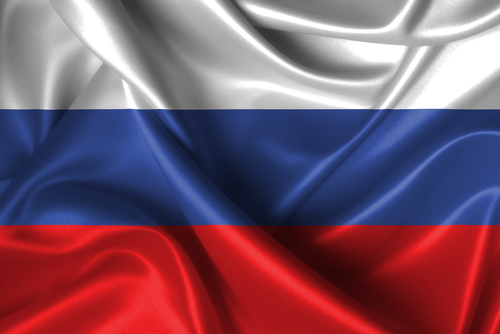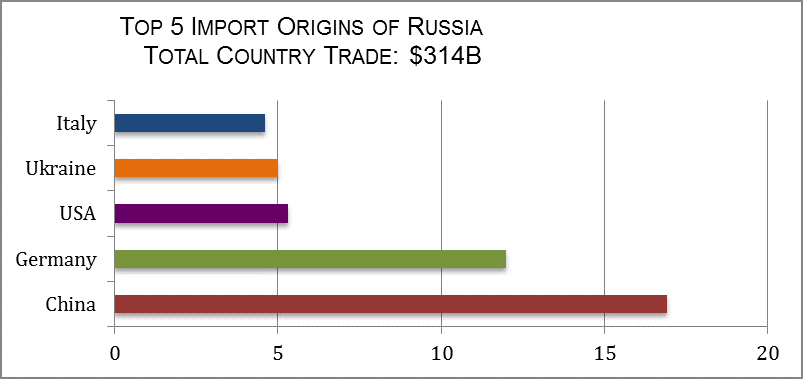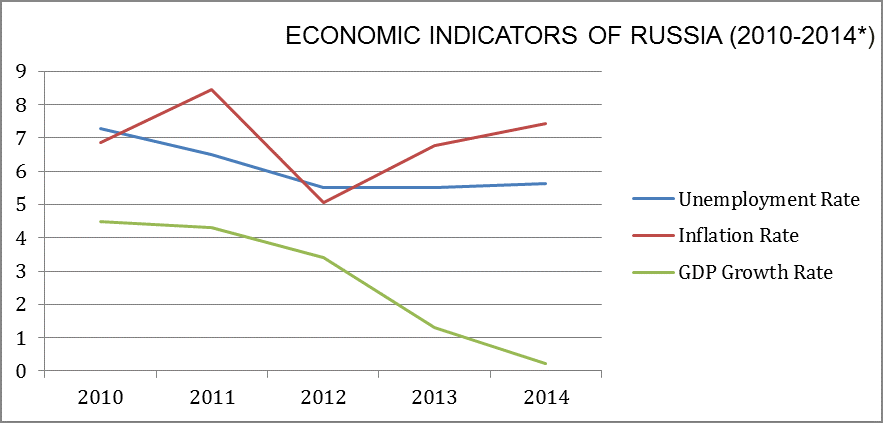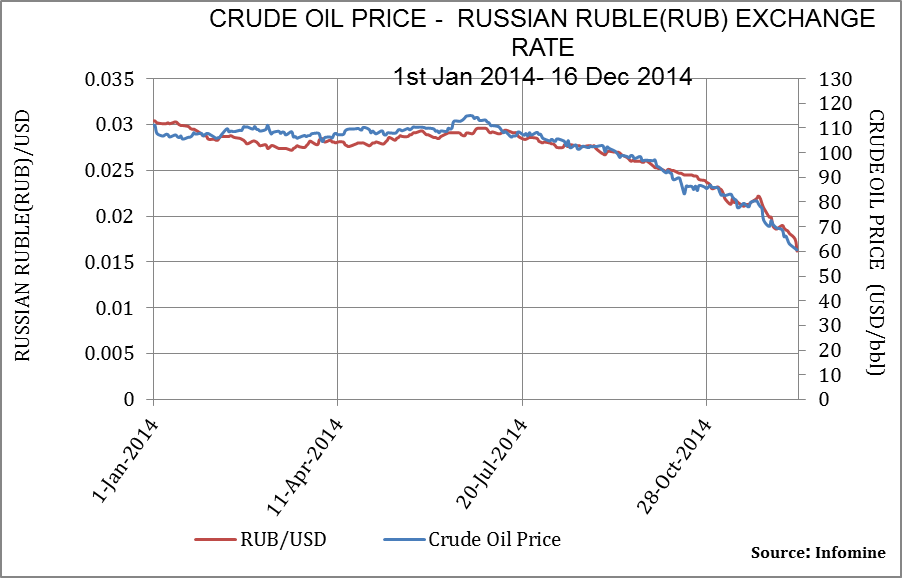Russia – Caught in a Perfect Storm

Please note that we are not authorised to provide any investment advice. The content on this page is for information purposes only.
2015 might not be a very pleasant one for Russia. The country faces the worst of financial failures since 1998. The Ukraine conflict, exclusion from G8, western sanctions; a high inflation, falling GDP growth and rising unemployment had already been heating the economy. But with the falling oil prices and domestic currency losing its value, Russia got caught in a perfect storm.
2015 might not be a very pleasant one for Russia. The country faces the worst of financial failures since 1998. The Ukraine conflict, exclusion from G8, western sanctions; a high inflation, falling GDP growth and rising unemployment had already been heating the economy. But with the falling oil prices and domestic currency losing its value, Russia got caught in a perfect storm.
The economy of Russia has been in deep trouble from the beginning of this year when its Central Bank used more than $75 billion to support the ruble. It has been trying hard to correct it and has already sold more than $10 billion in foreign currency in December itself, including nearly $2 billion on December 15, 2014. To stop a further fall in ruble on December 16, 2014 the Russian central bank announced in the middle of the night that it was pushing its main interest rate from 10.5 percent to 17 percent. “The decision was driven by the need to limit the risk of devaluation and inflation, both of which have recently significantly increased,” the bank said. Economic trouble can have some serious consequences across the world too. Europe is the first to feel the jitters with Euro’s strongest economy, Germany facing some tough situation. A destabilized Russia could cripple other economies too, especially the ones who are its trading partners.
Table of Contents
Rising Inflation and Falling GDP Growth Rate
The growth rate in Russia has dangerously declined over a period of time and this is aggravated by rising inflation. Russia relies on imports for practically everything except commodities. The inflation seems to soar and could even touch 10% by year-end. A falling GDP growth annually could be a sign that Russia may have to take some tough decisions like capital controls in the near future.
Unemployment Rate (%of total labor force)
*Figures till 17th December2014
Inflation Rate (% change)- Average consumer prices
GDP Annual Growth Rate with 2014 estimated by the end of this year.
Oil Price & Declining Ruble
Twenty percent of Russia’s GDP comes from its energy sector. The fall in oil prices is severely felt in Russia, where the ruble has lost around half its value against the US dollar in 2014. Russian economy is mainly oil driven and since oil prices and ruble are closely connected, any drop in oil price affects the ruble. Ruble’s fall has created a market panic both amongst investors, firms and public. With the falling ruble, more and more people are taking out their money from banks and converting them into USD or Euros. Russians are seen buying imported cars, refrigerators and other major appliances in a bid to spend their rubles before there is a price hike. On the other hand, Russian firms are quickly trying to pay off their foreign currency debts. So they’re selling off rubles, to buy dollars and euros, to pay off those debts. All this is further weakening the ruble and putting a strain on the currency market.
Ukraine Conflict & U.S. Sanctions
The Ukraine conflict was the reason Russia was excluded from the association of its member nations, which consisted of advanced economies. Along with Russia, Ukraine also continues to suffer. With Ukraine’s currency plunging, the country is already appealing for more funding support. Many economists blame the sanctions for worsening matters for Russia. Obama’s former ambassador to Moscow, Michael McFaul said, “It’s hard to disaggregate out the independent effects of the sanctions from the bigger story. Obviously the driver is oil prices. That said, there is no doubt that sanctions raise uncertainty about the Russian economy. Their own minister of economic development said today that the ruble is falling faster than the macroeconomic indicators would suggest it should be.”
Effects Across Other Economies
In recent times, mostly all economies are globally connected. So the effect of any country collapsing could severely damage its trading partners or other non-trading partners, directly or indirectly. We look at Russia and its trading partners likely to get affected by the ruble fall. Impacts of ruble’s decline will differ for every country and will depend on how much each country relies on Russian trade. Hence, countries, which are closely dependent on Russian trade or whose trade with Russia holds a sizeable portion in their GDP, could see their economies at risk.
Source: http://www.trademap.org/
Russia is world’s 9th largest exporter representing 2.9% of worldwide exports in 2013. Netherlands (13.1%) & China (6.8%) rank the highest as Russia’s export destinations. But it is countries like Belarus (3.2%), Latvia (1.9%) that is highly at risk from the weakened ruble since they have an export led economy.

Source: http://www.trademap.org/
In 2013, Russian Federation’s imports represented 1.68% of world imports for this product, its ranking in world imports is 18. Maximum of imports are from China (16.9%) & Germany (12%). Russia will definitely reduce imports till its currency is not stable and this will also impact its investment decisions abroad.
Effect on Industries and Production
A falling ruble is not good news for anyone. With Germany, Poland already seeing changes in their trade relations and economy, impact on industries remains huge as firms and trading partners closely watch the movement of the ruble. Energy companies, automobile and banking sector form a big part of Russian economy. After the western sanctions, in August Russia stopped its trade with western economies including Eurozone, which in turn backfired since Euro zone suffered a drop in its value of exports because Russia was its second largest customer. The sales of the automobiles are already witnessing a decline due to limited consumer spending. Foreign alliances and brands are witnessing shutdowns and decline in Russia due to both sanctions and the fall of ruble.
Future of Russia
Russia will definitely face some tough situations in coming times even when the central bank will try its best to make its currency strong. The recovery path might be a long one. Having said that, Russia could face political instability since market panic, loss of savings, rising unemployment and rising inflation leads to loss of faith in governance. Russia’s fallout could be very big for its allies and trading partners, especially Europe, which is already facing its own share of troubles. However, Russia remains optimistic about what is in store for it. “If the situation develops unfavorably, we will have to amend our plans. Beyond doubt, we will have to cut some (spending). But a positive turn and emergence from the current situation are inevitable,” President Vladimir Putin said to a packed conference center on December 18,2014. Russia is facing a perfect storm that could easily be a warning sign for the entire world.



.png)



